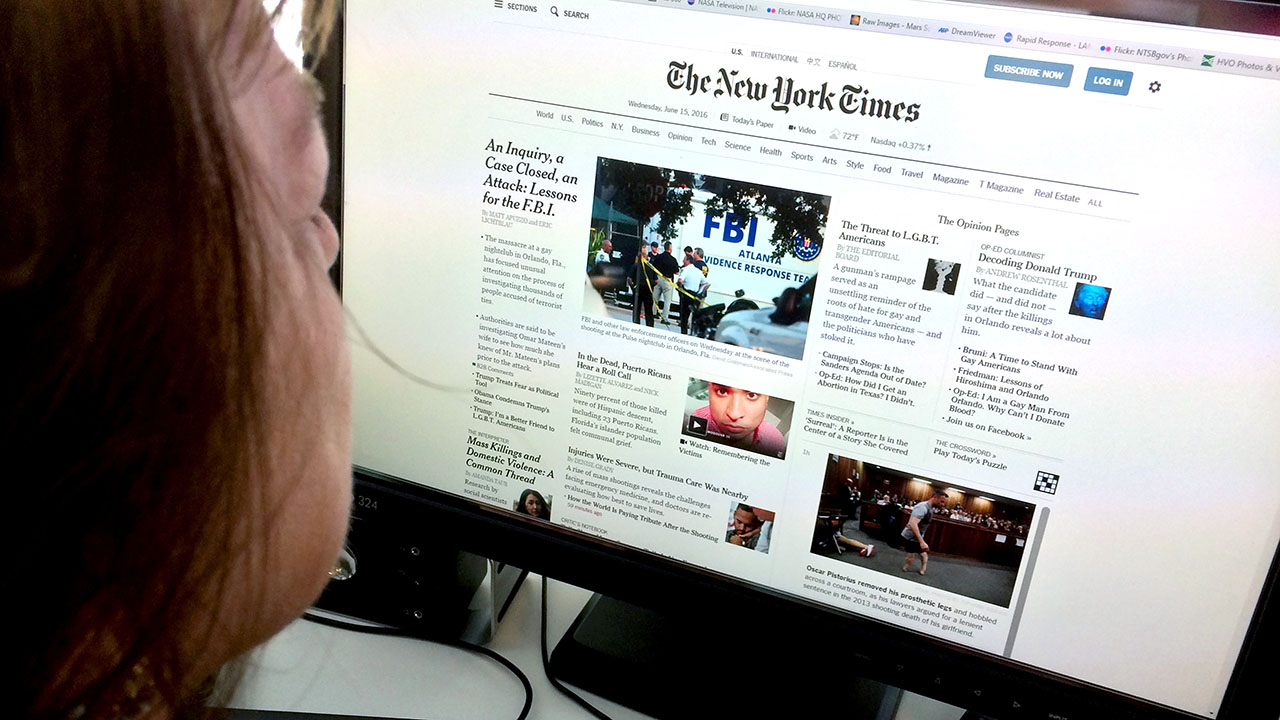How to Use stnews.live on Mobile
Wiki Article
The Effect of Social Media en route We Take In News Online
Social network has essentially changed news intake. It offers instant access to info, usually overshadowing typical media outlets. This rapid circulation comes with challenges. Customers face the threat of experiencing misinformation and ending up being trapped in echo chambers. The formulas driving tailored web content can cover varied perspectives. As these characteristics evolve, understanding their implications ends up being vital for informed engagement in public discussion. What methods might help navigate this complicated landscape?The Development of News Usage in the Digital Age
As technology advanced, the way individuals eaten news transformed substantially in the digital age (stnews.live). Typical papers and transmitted media began to decline as the net became a main source of information. On the internet systems offered instant access to newspaper article, videos, and podcasts, permitting users to stay informed any time. The ease of mobile gadgets further accelerated this change, enabling customers to get updates on the goAdditionally, the rise of news collectors and websites assisted in the intake of diverse viewpoints, encouraging customers to customize their news intake based on individual interests. This development also prompted wire service to adjust their approaches, focusing on electronic material and engaging visitors through multimedia formats. Therefore, the standard barriers of time and area in news delivery decreased, resulting in a more immediate and individualized news experience for target markets worldwide.
The Duty of Social Media Site Platforms in News Distribution
Social media systems have changed news circulation by giving instantaneous access to info. Their algorithm-driven content curation often focuses on interaction over precision, bring about significant trustworthiness difficulties (stnews.live). As individuals browse this landscape, the implications for news consumption and public discussion ended up being increasingly complexInstant News Accessibility
Although typical news outlets have actually long been the key source of details, the surge of social media sites systems has considerably changed how news is accessed and consumed. Instantaneous news accessibility has become a characteristic of the digital age, making it possible for customers to receive updates in genuine time. Systems such as Twitter, Facebook, and Instagram enable news to spread quickly, frequently going beyond standard media in rate and reach. Users can share stories, discuss occasions, and engage with reporters, producing a vibrant interaction in between the target market and news material. This immediacy promotes a culture of necessity, motivating customers to inquire swiftly. Consequently, the assumption for prompt news has improved journalistic practices, engaging news companies to adapt their strategies to meet the needs of a fast-paced electronic atmosphere.Algorithm-Driven Web content
While users proactively involve with material on social media, the algorithms that regulate these systems play an essential role in figuring out which newspaper article gain exposure. These formulas assess user actions, choices, and engagement metrics to curate customized news feeds. Consequently, specific stories may be amplified while others stay unknown, often focusing on mind-blowing or trending topics over substantive reporting. This selective direct exposure shapes users' assumptions of current occasions and affects public discourse. The dependence on algorithm-driven content can develop echo chambers, where individuals are primarily revealed to perspectives that line up with their very own ideas. The characteristics of news circulation on social media systems greatly affect just how individuals consume and interpret information in the electronic age.Trustworthiness Challenges
As users significantly transform to social networks for news, the trustworthiness of information experienced on these systems becomes a pushing worry. The decentralized nature of social networks allows anybody to publish web content, usually obscuring the lines between reliable journalism and misinformation. Formulas prioritize involvement over precision, leading to the extensive dissemination of sensational or misleading tales. This setting presents substantial difficulties for customers trying to recognize reliable sources. Social network systems, while striving to battle misinformation with fact-checking and content small amounts, run the gauntlet for inconsistencies and biases in their approaches. Eventually, the duty exists with individuals to critically review the news they take in, as the fast spread of details often surpasses confirmation efforts by systems.The Increase of Person Journalism and User-Generated Web Content
The rise of resident journalism has actually equipped day-to-day individuals to share news and point of views, often giving insights that typical media may ignore. This shift also provides substantial difficulties, specifically the spread of false information that can develop from unproven web content. As user-generated material ends up being extra common, the balance between genuine voices and accuracy in coverage continues to be a crucial issue.Encouraging Daily Voices

Obstacles of False information
While the rise of person journalism has opened up opportunities for diverse voices in the media landscape, it has also introduced considerable challenges connected to misinformation. The simplicity of sharing info via social networks platforms permits people to distribute news promptly, however this fast spread typically comes with the price of precision. User-generated material regularly lacks the extensive fact-checking and content oversight that link conventional journalism provides. Sensationalized or incorrect narratives can gain traction, deceiving audiences and forming public understanding. Furthermore, the mixing of viewpoint and reality within social media makes complex the difference in between credible info and false information. Consequently, consumers must browse a progressively complicated media setting, requiring essential believing skills to discern trusted news sources in the middle of the sound
False information and Its Implications for Public Discourse
As social media sites platforms significantly dominate the landscape of info dissemination, the expansion of false information poses substantial obstacles for public discussion. Misinformation, typically designed to misdirect or provoke psychological feedbacks, can misshape perceptions of truth and undermine count on reputable resources. This sensation results in polarized viewpoints, as individuals gravitate in the direction of echo chambers that enhance their beliefs, better setting departments within culture.The effects for public discourse are extensive. When people count on incorrect information, significant dialogue reduces, and the autonomous procedure suffers. Misinformation can incite concern and complication, impacting public health and wellness, safety, and political stability. As an outcome, fostering media proficiency comes to be necessary, equipping individuals to seriously evaluate details and discern truth from fiction. Resolving the difficulties presented by misinformation is crucial for protecting the integrity of public discussion and guaranteeing an educated populace capable of participating in constructive conversations.
The Impact of Algorithms on News Visibility
Offered the main function of algorithms in identifying material exposure, their influence on news consumption is extensive. These formulas, made use of by social networks systems, focus on certain sorts of material based upon individual engagement and choices. Because of this, news write-ups that line up with preferred trends or audience rate of interests are extra likely to be presented plainly, while less spectacular stories may be overlooked. This produces a setting where customers are subjected mainly to info that reinforces their perspectives, possibly causing echo chambers.The consistent evolution of algorithms implies that news companies have to adjust their techniques to align with these transforming criteria, commonly prioritizing clickbait or emotionally charged headings. The stability of news coverage can be endangered, as vital stories might not receive the exposure they deserve. The algorithmic shaping of news exposure as a result plays a crucial function in influencing public understanding and understanding of existing occasions.
The Shift Towards Visual Storytelling in News Media
Increasingly, news media is welcoming aesthetic narration as an effective tool to involve target markets. This method leverages pictures, videos, infographics, and interactive elements to share information more effectively than conventional text-based styles. As focus extends reduce, visuals supply a quick, impactful way to interact complex stories and get viewers' interest.Platforms like Instagram and TikTok have further increased this pattern, engaging wire service to adjust their content methods to fit these visually-driven atmospheres. By incorporating engaging visuals, news electrical outlets can enhance emotional links and foster higher understanding of topical concerns.
Moreover, visual narration permits even more diverse narratives, showcasing numerous viewpoints through dynamic discussions. As audiences significantly eat news through mobile phones, the change towards visuals not just deals with individual choices yet likewise assists to break down barriers to details accessibility. Inevitably, this evolution shows a broader change in exactly see this website how news is created and consumed in the electronic age.
Future Fads: Browsing the Altering Landscape of News Usage
While the electronic landscape continues to evolve, news intake is poised for substantial change driven by arising modern technologies and altering target market behaviors. As man-made knowledge and artificial intelligence breakthrough, customized news feeds will certainly come to be more widespread, allowing individuals to obtain material customized to their rate of interests. This customization Continued could result in higher interaction yet likewise increase problems concerning echo chambers and misinformation.Additionally, the surge of voice-activated tools and wise audio speakers will certainly influence exactly how news is provided, moving the emphasis from aesthetic to auditory styles. This fad may motivate news companies to adopt even more concise and appealing audio content.

Frequently Asked Inquiries
Exactly How Do Social Media Site Communications Affect News Reputation?
Social media site interactions can significantly influence assumptions of news credibility. Engagement metrics, such as sort and shares, frequently form audience trust fund, with preferred posts getting regarded legitimacy, despite the precision or dependability of the details offered.What Function Do Influencers Play in Shaping News Narratives?
Influencers significantly shape news narratives by leveraging their systems to enhance particular stories, often customizing web content to their audience. This can result in prejudiced point of views, influencing public understanding and focusing on sensationalism over factual reporting.How Can Users Identify Reliable News Resources on Social Network?
Individuals can recognize trusted news sources on social media by checking the source's credibility, confirming truths with numerous electrical outlets, evaluating the professionalism and trust of the web content, and identifying potential biases in reporting to assure precise information.What Impact Does Social Media Site Have on Standard Journalism Jobs?
Social media greatly impacts typical journalism jobs by altering profits models, minimizing need for print media, and cultivating competition from citizen journalists. Many specialists face task instability and have to adapt to quickly altering media landscapes.Just How Do Different Demographics Consume News on Social Media Site?
Various demographics display varied choices for news consumption on social media. Younger target markets favor platforms like TikTok and Instagram for fast updates, while older people tend to prefer Facebook and Twitter for extra in-depth conversations and short articles.Report this wiki page